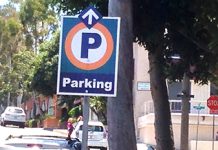By Jennifer Erickson | LB Indy
Due in part to higher-than-normal ocean temps, monsoon weather normally blocked by the mountain ridges managed to cross into Southern California this summer. The resulting thunderstorms created lightning that killed a man in Venice Beach in July and flash floods that claimed the life of a motorist and destroyed homes in the San Bernardino Mountains earlier this month.
Though Laguna Beach has so far escaped with little more than high humidity and drizzling rain, stories of cars in creek beds and mud-filled living rooms bore an uncomfortable resemblance to the unprecedented local flood of Dec. 22, 2010, which caused $12 million in damages to Laguna Canyon residences and downtown businesses.
The unusual weather gives new urgency to forecasts predicting the onset of El Niño, potentially bringing heavy rains this winter and increasing the danger of local flash floods.
Currently, weather forecasters for the National Oceanic Atmospheric Administration (NOAA) are predicting about an 80 percent chance of an El Niño for this winter, said Laguna Beach Marine Safety Captain Tom Trager. But there isn’t really a correlation between El Niño and wet weather in Southern California, unless it is a very strong El Niño, he said. And since the prediction right now is for a weak to moderate El Niño, we have “a glimmer of hope,” Trager added, to avoid the torrential downpours that cause flooding and mudslides.
Even so, winter storm preparations are well underway throughout town, including a score of recommendations pushed by a post-2010 flood task force that include a warning system that will give residents more lead time to react. But deficiencies in infrastructure laid bare by the floods of four years ago have yet to be tackled for various reasons.
“I feel satisfied that the city staff is doing all they can, given the uncertainty of the predictions,” said Sue Kempf, chair of the city’s Emergency/Disaster Preparedness Committee, which received a storm readiness report last week from Steve May, the city’s director of public works. Staff has been “very proactive,” agreed committee member Matt Lawson.
Readiness preparation includes working with businesses downtown and along the Laguna Canyon channel to get their flood gates installed, according to City Manager John Pietig. Additionally, the city storm drain inlets get cleaned out annually before the rainy season, and sand bags will be made available to residents to fill when significant rains are in the forecast.
In the event of a disaster, the city now has 102 CERT (Community Emergency Response Team) volunteers who now have radio equipment, and the city’s emergency operations center received a cash infusion this summer for improvements including a smart board and provisions for first responders.
To keep communication open in the event of a power failure, the City Council in June approved spending $18,000 for local FM radio station KX 93.5 to install emergency generators and other emergency preparedness gear.
For residents of Sun Valley Drive in Laguna Canyon, the moderating El Nino predictions are welcome. The City Council just recently approved the final permit to clean up a dump site that spilled glass and other detritus into their neighborhood during the 2010 flood. That should begin no later than Sept. 15 and be completed by October, before the rainy season begins, according to project manager Bob Burnham.
The work entails removal of about 7,000 cubic yards of burn waste from private households accumulated over about 20 years starting in the late 1940s, according to a staff report. It also includes restoration and re-vegetation of the hillside.
By January 2013, 21 of 26 recommendations by the Laguna Canyon Flood Mitigation Task Force had been completed. They largely involve readiness precautions, alert systems, education and floodplain management.
More costly flood control infrastructure changes, requiring participation of other agencies, remain incomplete. The city and Caltrans have both budgeted funds for a project to increase the capacity of the downtown box culvert that overflowed during the 2010 deluge, but they haven’t yet finalized an agreement. The city already pledged $6.7 million over four years, and Caltrans has pledged to reimburse $1.1 million to the city once the work is completed.
City staff also met with Caltrans last year to address deficiencies in the capacity of drainage culverts crossing Laguna Canyon Road between Big Bend and the San Joaquin Hills Transportation Corridor. Attempts to engage Orange County’s director of public works in the effort hit a bureaucratic log jamb, but Caltrans is moving ahead with improvements upstream of El Toro Road that could be completed in a year, pending a few environmental hurdles, according to May.
County staff rejected a city staff request that they reconstruct the Laguna Audubon basin so that it could be manually operated to drain within hours in advance of a severe storm.
Other infrastructure measures, such as the suggestion of Laguna Canyon resident and local architect Paul Barnard that floodwaters be captured in containment basins upstream, have yet to be considered.
In the meantime, residents and businesses can also do their part in preparing for the rain. To keep abreast of possible emergencies, they can sign up for both Alert OC and the traffic alert system through the city’s website. Property owners should make sure their gutters and any terrace drains on their slopes are clean and functioning. Residents should also have an emergency kit packed and ready to go in case of evacuation, store important papers in fireproof and watertight containers, and have a family/employee communications plan in place. Anyone in a flood prone area should move valuables to the highest level.
And we can hope it rains, but doesn’t pour.





[…] to the article (“El Nino Forecasts Propel Storm Readiness,” Aug. 15) the city of Laguna Beach is taking […]